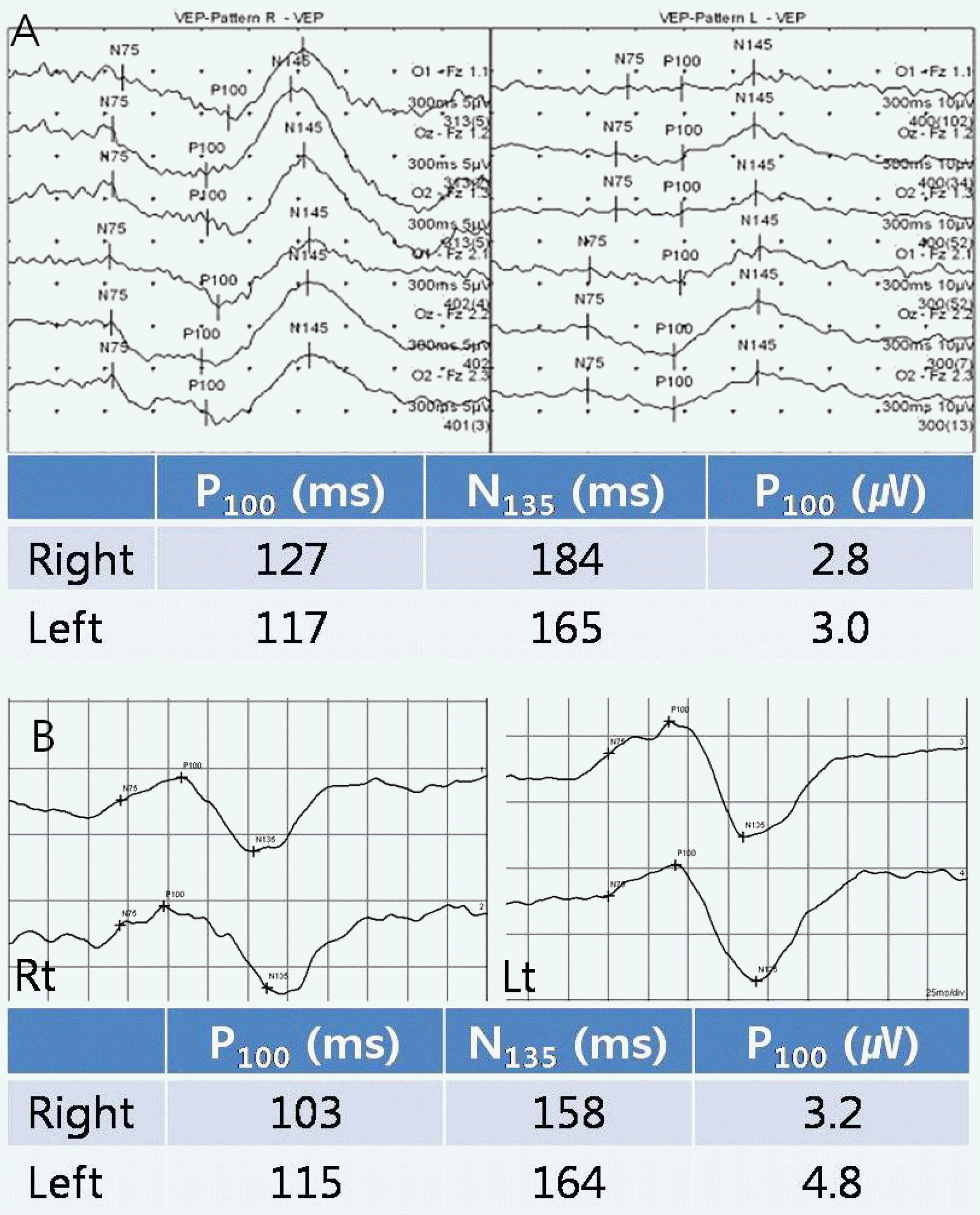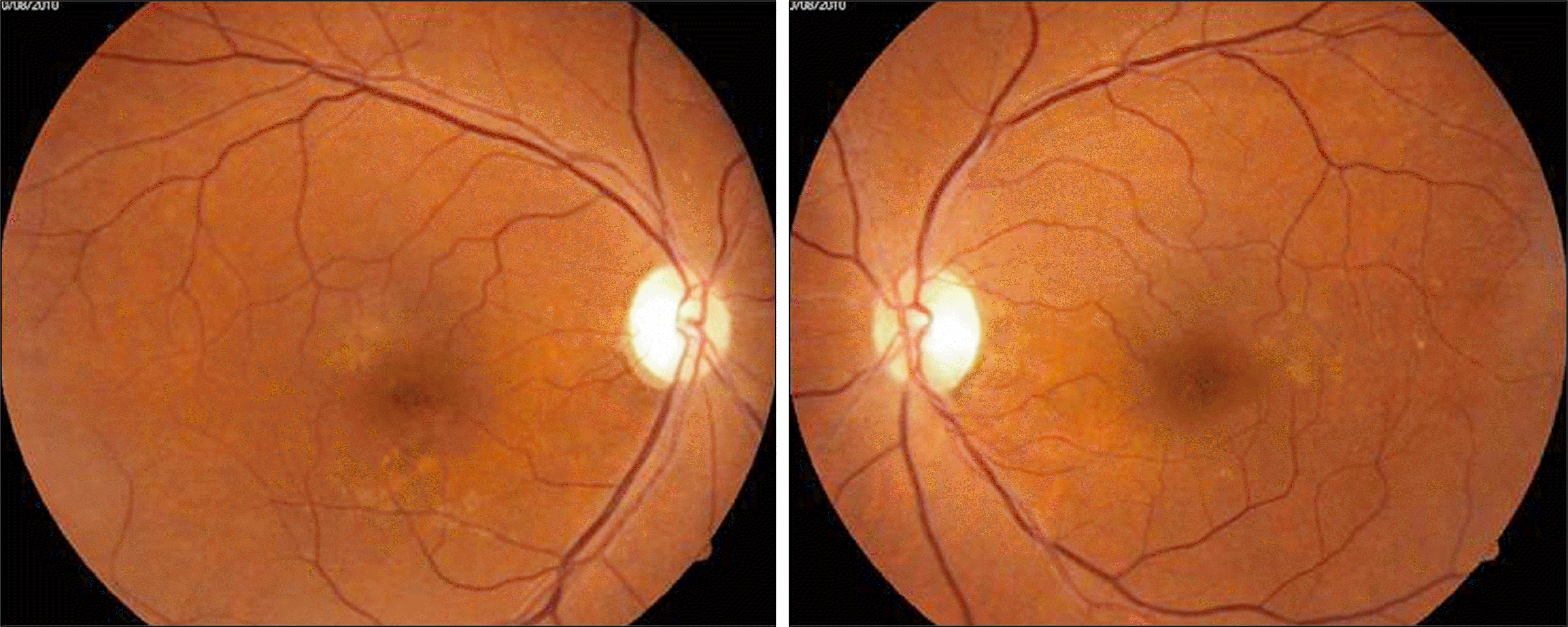Abstract
Case summary
A 74-year-old woman presented to our clinic with decreased visual acuity in both eyes. Such symptoms started 1 month prior to her visit, after sudden onset of left-side motor power weakness and dysphasia. Following the initial symptoms, our patient consecutively experienced worsening dysphagia, ptosis, and lateral gaze limitation. We confirmed the diagnosis as Miller Fischer syndrome with a positive anti-GQ1b antibody serology. She received immunoglobulin treatment for 5 days in other departement. She visited our clinic due to continuing diplopia, decrease of visual acuity and gait disturbance. On initial examination, the corrected visual acuity was 0.5 in both eyes. Ptosis of both eyelids, esodeviation, limitation in ocular movement was noted. The fundoscopic examinations revealed relatively pale optic disc. There was decrease in color vision in both eyes. The visual evoked potential test showed low amplitude and delayed latency in P100 wave in both eyes. Two months after her initial visit to our department her symptoms started to improve, and after 4 months all the initial problems resolved completely and her corrected visual acuity checked out to be 0.8 in both eyes and VEP abnormality was recovered.
References
1. Fisher M. An unusual variant of acute idiopathic polyneuritis (syndrome of ophthalmoplegia, ataxia and areflexia). N Engl J Med. 1956; 255:57–65.

2. Chiba A, Kusunoki S, Obata H, et al. Ganglioside composition of the human cranial nerves, with special refrence to pathophysiology of Miller Fisher syndorme. Brain Res. 1997; 745:32–6.
3. Berlit P, Rakicky J. Miller Fisher syndrome. Review of the literature. J Clin Neuroophthalmol. 1992; 12:57–63.
4. LI H, Yuan J. Miller Fisher syndrome: toward a more comprehensive understanding. Chin Med J. 2001; 104:235–9.
5. Toshniwal P. Demyelinating optic neuropathy with Miller Fisher syndrome: the case for overlap syndromes with central and peripheral demyelination. J Neurol. 1987; 234:353–8.
6. Colding-Jorgensen E, Vissing J. Visual impairment in anti-GQ1b positive Miller Fisher syndrome. Acta Neurol Scand. 2001; 103:259–60.

7. Chan J. Optic neuritis in anti-GQ1b positive recurrent Miller Fisher syndrome. Br J ophthalmol. 2003; 87:1185–6.

8. Lo YL. Clinical and immunological spectrum of the Miller Fisher syndrome. Muscle Nerve. 2007; 36:615–27.

9. Roberts M, Willison H, Vincent A, Newsom-Davis J. Serum factor in Miller Fisher varient of Guillain-Barre syndrome and neuro-transmitter release. Lancet. 1994; 343:454–5.
10. Buchwald B, Weishaupt A, Toyka KV, Dudel J. Pre- and post-synaptic blockade of neuromuscular transmission by Miller Fisher syndrome IgG at mouse motor nerve terminals. Eur J Neurosci. 1998; 10:281–90.
11. Odaka M, Yuki N, Hirata K. Anti-GQ1b IgG antibody syndrome: clinical and immunological range. J Neurol Neurosurg Psychiatry. 2001; 70:50–5.

12. Goodall JA, Kosmidis JC, Geddes AM. Effect of corticosteroids on course of Guillain-Barre syndrome. Lancet. 1974; 1:524–6.
13. Zifko U, Drlicek M, Senantka G, Grisold W. High dose immunoglobulin therapy is effective in the Miller Fisher syndrome. J Neurol. 1994; 241:178–9.

14. Yeh JH, Chen WH, Chen JR, Chiu HC. Miller Fisher syndrome with central involvement: successful treatment with plasmapheresis. Ther Apher. 1999; 3:69–71.

15. Son MK, Ahn HS. Miller Fisher syndrome. J Korean Ophthalmol Soc. 1997; 38:1470–9.
16. Ahn JH, Lee SG. A Case of Anti-GQ1b-Positive atypical Miller Fisher syndrome with pupil involvement. J Korean Ophthalmol Soc. 2009; 50:645–8.

17. Yuki N, Sato S, Tsuji S, Miyatake T. An immunologic abnormality common to Bickerstaff's brain stem encephalitis and Fisher's syndrome. J Neurol Sci. 1993; 118:83–7.

18. Robbins MS, Roth S, Swerdlow ML, et al. Optic neuritis and palatal dysarthria as presenting features of post-infectious GQ1b antibody syndrome. Clin Neurol Neurosurg. 2009; 111:465–6.

19. Maier H, Schmidbauer M, Pfausler B, et al. Central nervous system pathology in patients with the Guillain-Barrë syndrome. Brain. 1997; 120:451–64.
Figure 1.
Photographs of nine cardinal direction at initial visit show esodeviation, limitation of ocular motility in all direction, and bilateral blepharoptosis.

Figure 3.
Pattern visual evoked potential (VEP) at first visit showing delayed P100 latency and decreased amplitude in both eyes (A). Four months after the onset of symptom, delay of P100 latency in right eye and decrease of P100 amplitude in both eyes was completely recovered but delay of P100 latency of left eye was still persisted (B).





 PDF
PDF ePub
ePub Citation
Citation Print
Print




 XML Download
XML Download